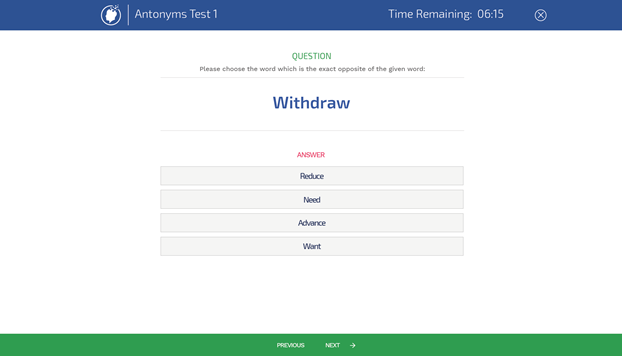Employers choose to use psychometric testing during their recruitment process to help give a better overall evaluation of candidate’s and their suitability for the job that they’re applying for. Psychometric testing could help to gauge the future performance of candidate's and also improve employee retention by making successful hiring decisions.
The most common way for employers to use aptitude tests such as an antonyms test is online. Traditionally, aptitude tests have taken the form of pen and paper, but due to benefits such as saving valuable time and money, online testing is used more frequently. Undertaking aptitude tests is usually the follow-up action after an employer has accepted your CV or initial job application form.
If you pass the online test in some cases you are invited to an assessment centre, which is usually done by larger employers. The term assessment center is used due to the fact that employers conduct this extended assessment in a single center, either an office of the employers themselves or at a third-party venue. The assessment centre is often (but not always) a day that constitutes the final stage of the application process. At the assessment center, they will ask you to sit a repeat test at the assessment center to verify your earlier test scores, therefore, don’t get your friends or family to help you out during the online test!
Preparing for an assessment centre or online aptitude test can be stressful due to the fact that you don’t know what to expect. The best way to familiarize yourself is with practice aptitude tests that mimic the tests used by employers and recruiters. Assessment-Training.com has prepared thousands of candidates for their assessments and aptitude tests by offering realistic test simulations with fully worked solutions.
By practicing antonym tests you can improve your performance during the real test by familiarizing yourself with the format and time-pressure.
Questions of antonyms consist of a stem word and four or five answer option words. Candidates are expected to choose the word from the options which is farthest in meaning to the given word. You don’t have to find a perfect opposite for the given stem word but the best opposite from the given set op answer possibilities.
There are different categories of antonyms that are used in antonym tests, such as:
- Gradable antonyms (large : small, hot : cold): Gradable antonyms are typically pairs of adjectives that can be qualified by adverbs such as very, quite, extremely etc. For example, we can say ‘the teacher is friendly or the teacher is unfriendly’. However, as friendly and unfriendly are gradable antonyms, we can also qualify how friendly or unfriendly the teacher is: The teacher was surprisingly unfriendly/friendly. The teacher was very unfriendly/friendly etc. Other examples include: heavy : light, fat : skinny, dark : light, young : old, early : late, empty : full.
- Complementary antonyms (black : white, boy : girl): Complementary antonyms are pairs of words that are opposite in meaning, cannot be graded and are mutually exclusive. That is, they can exist independently of each other. Examples for complementary antonyms include push : pull, right : wrong, yes : no, exit : entrance, lift : drop.
- Relational antonyms: A relational antonym is one of a pair of words with opposite meanings, where opposite makes sense only in the context of the relationship between the two meanings. For instance, the relation antonym predator : prey. There is no lexical opposite of predator, but predator and prey are opposite within the context of their relationship. Other examples include: husband : wife, doctor : patient, teach : learn, parent : child.


